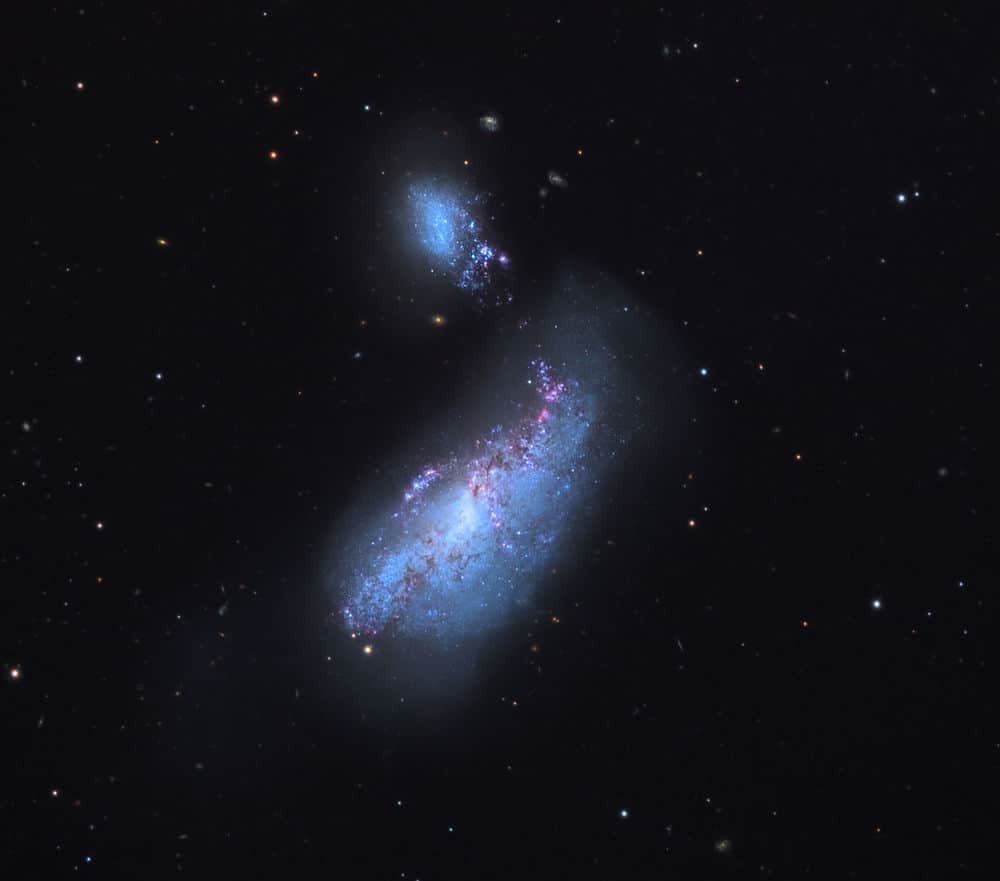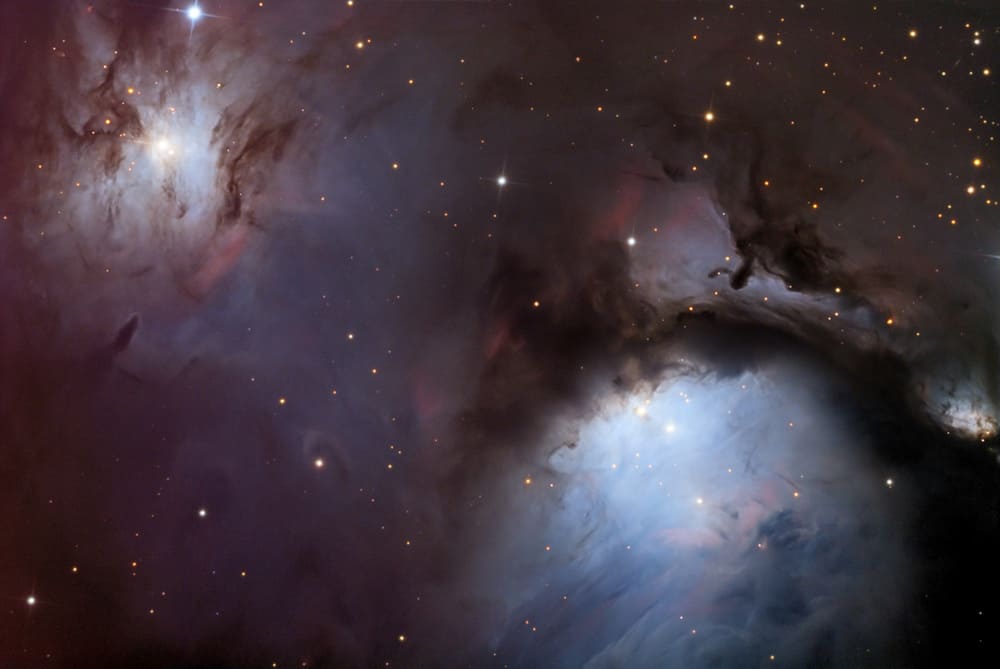Blog
In flamenco a tango is one of the flamenco palos closely related in form and feeling to the rumba flamenca. It is often performed as a finale to a flamenco tiento. Its compás and llamada are the same as that of the farruca and share the farruca’s lively nature. However, the tango is normally performed in the A Phrygian mode. In some English sources the flamenco tango is written with an -s; “the tangos is…” The flamenco tango is distinct from the flamenco rumba primarily through the guitar playing. In Rumba the guitar flows more freely, whereas in Tangos the accents on beats 2, 3 & 4 are marked clearly with heavy strumming.
more...NGC 4490, also known as the Cocoon Galaxy, is a barred spiral galaxy in the constellation Canes Venatici. It lies at a distance of 25 million light years from Earth. It interacts with its smaller companion NGC 4485 and as a result is a starburst galaxy. NGC 4490 and NGC 4485 are collectively known in the Atlas of Peculiar Galaxies as Arp 269. NGC 4490 is located 3/4° northwest of beta Canum Venaticorum and with apparent visual magnitude 9.8, can be observed with 15×100 binoculars. It is a member of Herschel 400 Catalogue. It belongs in Canes Venatici galaxy cloud II.
It was discovered by William Herschel in 1788. Two supernovae have been observed in NGC 4490, SN 1982F, and type II-P SN 2008ax, with peak magnitude 16.1

Larry Coryell (born Lorenz Albert Van DeLinder III; April 2, 1943 – February 19, 2017) was an American jazz guitarist known as the “Godfather of Fusion“.
Larry Coryell was born in Galveston, Texas. He never knew his biological father, a musician. He was raised by his stepfather Gene, a chemical engineer, and his mother Cora, who encouraged him to learn piano when he was four years old.
In his teens he switched to guitar. After his family moved to Richland, Washington, he took lessons from a teacher who lent him albums by Les Paul, Johnny Smith, Barney Kessel, and Tal Farlow. When asked what jazz guitar albums influenced him, Coryell cited On View at the Five Spot by Kenny Burrell, Red Norvo with Strings, and The Incredible Jazz Guitar of Wes Montgomery. He liked blues and pop music and tried to play jazz when he was eighteen. He said that hearing Wes Montgomery changed his life.
Coryell graduated from Richland High School, where he played in local bands the Jailers, the Rumblers, the Royals, and the Flames. He also played with the Checkers from Yakima. He then moved to Seattle to attend the University of Washington.
In September 1965, Coryell moved to New York City, where he attended Mannes School of Music. After moving to New York, he listened to classical composers such as Bartók, Debussy, Ravel, Stravinsky, and Shostakovich.
He replaced guitarist Gábor Szabó in Chico Hamilton‘s quintet. In 1967–68, he recorded with Gary Burton. During the mid-1960s he played with the Free Spirits, his first recorded band. His music during the late-1960s and early-1970s combined rock, jazz, and eastern music.
He married three times during his life. First to writer-actress Julie Nathanson, daughter of actress Carol Bruce. She appeared on the cover of his albums, Lady Coryell, Larry Coryell at the Village Gate, and The Lion and the Ram and wrote the book Jazz-Rock Fusion based on interviews with musicians such as Chick Corea and John McLaughlin.
more...Leon Russell (born Claude Russell Bridges; April 2, 1942 – November 13, 2016) was an American musician and songwriter who was involved with numerous bestselling pop music records during his 60-year career. His genres included pop, country, rock, folk, gospel, bluegrass, rhythm and blues, folk rock, blues rock, surf, standards, and Tulsa Sound.
His collaborations rank as some of the most successful in music history, and as a touring musician he performed with hundreds of notable artists. He recorded 33 albums and at least 430 songs. He wrote “Delta Lady“, recorded by Joe Cocker, and organized and performed with Cocker’s Mad Dogs and Englishmen tour in 1970. His “A Song for You“, added to the Grammy Hall of Fame in 2018, has been recorded by more than 200 artists, and his “This Masquerade” by more than 75.
As a pianist, he played in his early years on albums by The Beach Boys, Dick Dale and Jan and Dean. On his first album, Leon Russell, in 1970, the musicians included Eric Clapton, Ringo Starr, and George Harrison. One of his biggest early fans, Elton John, said Russell was a “mentor” and an “inspiration”. They recorded their album The Union in 2010, which earned them a Grammy nomination.
Russell produced and played in recording sessions for, among others Bob Dylan, Frank Sinatra, Ike & Tina Turner, and The Rolling Stones. He wrote and recorded the hits “Tight Rope” and “Lady Blue“. He performed at The Concert for Bangladesh in 1971 along with Harrison, Dylan, and Clapton, for which he earned a Grammy Award.
His recordings earned six gold records. He received two Grammy awards from seven nominations. In 2011, he was inducted into both the Rock and Roll Hall of Fame and the Songwriters Hall of Fame.
Russell was born in Lawton, Oklahoma, and began playing the piano at the age of four.
more...Marvin Gaye (born Marvin Pentz Gay Jr.; April 2, 1939 – April 1, 1984 Washington DC) was an American singer, songwriter, and record producer. He helped to shape the sound of Motown in the 1960s, first as an in-house session player and later as a solo artist with a string of hits, earning him the nicknames “Prince of Motown” and “Prince of Soul”.
Gaye’s Motown hits include “Ain’t That Peculiar“, “How Sweet It Is (To Be Loved By You)“, and “I Heard It Through the Grapevine“, and he recorded duets with Mary Wells, Kim Weston, Diana Ross, and Tammi Terrell. During the 1970s, he recorded the albums What’s Going On and Let’s Get It Onand became one of the first artists in Motown to break away from the reins of a production company. His later recordings influenced several contemporary R&B subgenres, such as quiet storm and neo soul. He was a tax exile in Europe in the early 1980s, then he released the 1982 hit “Sexual Healing” which won him his first two Grammy Awards on the album Midnight Love. Gaye’s last televised appearances were at the 1983 NBA All-Star Game, where he sang “The Star-Spangled Banner“; Motown 25: Yesterday, Today, Forever; and Soul Train.
Gaye’s father Marvin Gay Sr. fatally shot him on April 1, 1984, the day before his 45th birthday, at their house in the West Adams district of Los Angeles. Many institutions have posthumously bestowed Gaye with awards and other honors including the Grammy Lifetime Achievement Award, and inductions into the Rhythm and Blues Music Hall of Fame, the Songwriters Hall of Fame, and the Rock and Roll Hall of Fame.
more...Booker Little Jr. (April 2, 1938 – October 5, 1961) was an American jazz trumpeter and composer. He appeared on many recordings in his short career, both as a sideman and as a leader. Little performed with Max Roach, John Coltrane, and Eric Dolphy and was strongly influenced by Sonny Rollins and Clifford Brown. He died at age 23. Little was born in Memphis, Tennessee. He was the fourth child of Booker, a Pullman porter (who was also a trombonist) and his wife, Ophelia (who played piano). Little graduated from Manassas High School. He studied trumpet at the Chicago Conservatory with Joseph Summerhill from 1956 to 1958 and it was during this time that he worked with leading local musicians such as Johnny Griffin. Later, after moving to New York, while he lived with Sonny Rollins, Little became associated with drummer Max Roach and multi-instrumentalist Eric Dolphy, recording with them both as a sideman and a leader.
With Dolphy, he co-led a residency at the Five Spot club in New York in June 1961, from which three albums were eventually issued by the Prestigelabel. It was during this stint that he began to show promise of expanding the expressive range of the “vernacular” bebop idiom which originated with Clifford Brown, his most obvious influence as a performer. He also appeared on Dolphy’s album Far Cry (New Jazz 8270), recorded on December 21, 1960.
Little died of complications resulting from uremia on October 5, 1961, in New York City. He was survived by his wife, two sons (Booker T. III, and Larry Cornelius), and two daughters (Larue Cornelia and Ana Dorsey).
more...Alien Spacecraft were spotted today at several world locations. Apparently they contacted the WH but the president refused to respond claiming FAKE NEWS!

Messier 78 or M 78, also known as NGC 2068, is a reflection nebula in the constellation Orion. It was discovered by Pierre Méchain in 1780 and included by Charles Messier in his catalog of comet-like objects that same year.
M78 is the brightest diffuse reflection nebula of a group of nebulae that includes NGC 2064, NGC 2067 and NGC 2071. This group belongs to the Orion B molecular cloud complex and is about 1,350 light-years distant from Earth. M78 is easily found in small telescopes as a hazy patch and involves two stars of 10th and 11th magnitude. These two B-type stars, HD 38563 A and HD 38563 B, are responsible for making the cloud of dust in M78 visible by reflecting their light.
The M78 cloud contains a cluster of stars that is visible in the infrared. Due to gravity, the molecular gas in the nebula has fragmented into a hierarchy of clumps, the denser cores of which about to form stars with masses of up to 5 M☉. About 45 variable stars of the T Tauri type, young stars still in the process of formation as well as some 17 Herbig–Haro objects are known in M78.

Gilbert Scott-Heron (April 1, 1949 – May 27, 2011) was an American soul and jazz poet, musician, and author, known primarily for his work as a spoken-word performer in the 1970s and 1980s. His collaborative efforts with musician Brian Jackson featured a musical fusion of jazz, blues, and soul, as well as lyrical content concerning social and political issues of the time, delivered in both rapping and melismatic vocal styles by Scott-Heron. His own term for himself was “bluesologist”, which he defined as “a scientist who is concerned with the origin of the blues”.
His music, most notably on the albums Pieces of a Man and Winter in America in the early 1970s, influenced and foreshadowed later African-American music genres such as hip hop and neo soul. Scott-Heron is considered by many to be the first rapper/MC ever. His recording work received much critical acclaim, especially one of his best-known compositions, “The Revolution Will Not Be Televised“.[10] AllMusic‘s John Bush called him “one of the most important progenitors of rap music,” stating that “his aggressive, no-nonsense street poetry inspired a legion of intelligent rappers while his engaging songwriting skills placed him square in the R&B charts later in his career.”
Scott-Heron remained active until his death, and in 2010 released his first new album in 16 years, entitled I’m New Here. A memoir he had been working on for years up to the time of his death, The Last Holiday, was published posthumously in January 2012. Scott-Heron received a posthumous Grammy Lifetime Achievement Award in 2012. He also is included in the exhibits at the National Museum of African American History and Culture (NMAAHC) that officially opened on September 24, 2016, on the National Mall, and in an NMAAHC publication, Dream a World Anew.
https://www.youtube.com/watch?v=qGaoXAwl9kw
more...James Chambers, OM (born 1 April 1948), known professionally as Jimmy Cliff, is a Jamaican ska and reggae musician, multi-instrumentalist, singer, and actor. Along with Bunny Wailer he is one of only two living musicians to hold the Order of Merit, the highest honour that can be granted by the Jamaican government for achievements in the arts and sciences.
Cliff is best known among mainstream audiences for songs such as “Wonderful World, Beautiful People”, “Many Rivers to Cross“, “You Can Get It If You Really Want“, “The Harder They Come“, “Reggae Night“, and “Hakuna Matata“, and his covers of Cat Stevens‘s “Wild World” and Johnny Nash‘s “I Can See Clearly Now” from the film Cool Runnings. He starred in the film The Harder They Come, which helped popularize reggae across the world, and Club Paradise. Cliff was one of five performers inducted into the Rock and Roll Hall of Fame in 2010.
Jimmy Cliff was born in Somerton District, Saint James, Jamaica. He began writing songs while still at primary school in St. James, listening to a neighbour’s sound system. In 1962 his father took him to Kingston to go to Kingston Technical school, where he ended up sharing his cousin’s one rented room in East Kingston.
https://www.youtube.com/watch?v=SF3IktTk_pQ
more...Irving Sidney “Duke” Jordan (April 1, 1922 – August 8, 2006) was an American jazz pianist.
Jordan was born in New York and raised in Brooklyn where he attended Boys High School. An imaginative and gifted pianist, Jordan was a regular member of Charlie Parker‘s quintet during 1947–48, which also featured Miles Davis. He participated in Parker’s Dial sessions in late 1947 that produced “Dewey Square”, “Bongo Bop”, “Bird of Paradise”, and the ballad “Embraceable You“. These performances are featured on Charlie Parker on Dial.
Jordan had a long solo career from the mid-1950s onwards, although for a period in the mid-1960s he drove a taxi in New York. After periods accompanying Sonny Stitt and Stan Getz, he performed and recorded in the trio format. His most notable composition, “Jordu“, became a jazz standard when trumpeter Clifford Brown adopted it into his repertoire.
Beginning in 1978 he lived in Copenhagen, Denmark, having recorded an extensive sequence of albums for the SteepleChase label; his first record date for the company was in 1973. He was reported not to have changed his style over the course of his career. Some of his best live recordings are available on SteepleChase, or Marshmallow Records, a Japanese label.
From 1952 to 1962 he was married to the jazz singer Sheila Jordan. Their union produced a daughter, Tracey J. Jordan. He died in Valby, Copenhagen.
more...Alberta Hunter (April 1, 1895 – October 17, 1984) was an American jazz singer and songwriter who had a successful career from the early 1920s to the late 1950s, and then stopped performing. After twenty years of working as a nurse, in 1977 Hunter successfully resumed her popular singing career until her death.
Hunter was born in Memphis, Tennessee, to Laura Peterson, who worked as a maid in a Memphis brothel, and Charles Hunter, a Pullman porter. Hunter said she never knew her father. She attended Grant Elementary School, off Auction Street, which she called Auction School, in Memphis. She attended school until around age 15.
One of her first notable experiences as an artist was at the Panama Club, a white-owned club with a white-only clientele that had a chain in Chicago, New York and other large cities. Hunter’s first act was in an upstairs room, far from the main event; thus, she began developing as an artist in front of a cabaret crowd. “The crowd wouldn’t stay downstairs. They’d go upstairs to hear us sing the blues. That’s where I would stand and make up verses and sing as I go along.” Many claim her appeal was based on her gift for improvising lyrics to satisfy the audience. Her big break came when she was booked at Dreamland Cafe, singing with King Oliver and his band.
She peeled potatoes by day and hounded club owners by night, determined to land a singing job. Her persistence paid off, and Hunter began a climb from some of the city’s lowest dives to a headlining job at its most prestigious venue for black entertainers, the Dreamland ballroom. She had a five-year association with the Dreamland, beginning in 1917, and her salary rose to $35 a week.
She first toured Europe in 1917, performing in Paris and London. The Europeans treated her as an artist, showing her respect and even reverence, which made a great impression on her.
Her career as singer and songwriter flourished in the 1920s and 1930s, and she appeared in clubs and on stage in musicals in both New York and London. The songs she wrote include the critically acclaimed “Downhearted Blues” (1922).
She recorded several records with Perry Bradford from 1922 to 1927.
Hunter recorded prolifically during the 1920s, starting with sessions for Black Swan in 1921, Paramount in 1922–1924, Gennett in 1924, OKeh in 1925–1926, Victor in 1927 and Columbia in 1929. While still working for Paramount, she also recorded for Harmograph Records under the pseudonym May Alix.
Hunter wrote “Downhearted Blues” with Lovie Austin and recorded the track for Ink Williams at Paramount Records. She received only $368 in royalties. Williams had secretly sold the recording rights to Columbia Records in a deal in which all royalties were paid to him. The song became a big hit for Columbia, with Bessie Smith as the vocalist. This record sold almost 1 million copies. Hunter learned what Williams had done and stopped recording for him.
https://www.youtube.com/watch?v=BmFtwwCOmmo
In 1928, Hunter played Queenie opposite Paul Robeson in the first London production of Show Boat at Drury Lane. She subsequently performed in nightclubsthroughout Europe and appeared for the 1934 winter season with Jack Jackson‘s society orchestra at the Dorchester, in London. One of her recordings with Jackson is “Miss Otis Regrets“.[17]
While at the Dorchester, she made several HMV recordings with the orchestra and appeared in Radio Parade of 1935 (1934),[17] the first British theatrical film to feature the short-lived Dufaycolor, but only Hunter’s segment was in color. She spent the late 1930s fulfilling engagements on both sides of the Atlantic and the early 1940s performing at home.
Hunter eventually moved to New York City. She performed with Bricktop and recorded with Louis Armstrong and Sidney Bechet. She continued to perform on both sides of the Atlantic, and as the head of the U.S.O.’s first black show, until her mother’s death.
more...This enigmatic region, about 26,000 light years away toward the constellation of the Archer (Sagittarius), glows in every type of light that we can see. In the featured image, high-energy X-ray emission captured by NASA’s orbiting Chandra X-Ray Observatory appears in green and blue, while low-energy radio emission captured by SARAO‘s ground-based MeerKATtelescope array is colored red. Just on the right of the colorful central region lies Sagittarius A (Sag A), a strong radio source that coincides with Sag A*, our Galaxy’s central supermassive black hole. Hot gas surrounds Sag A, as well as a series of parallel radio filaments known as the Arc, seen just left of the image center. Numerous unusual single radio filaments are visible around the image. Many stars orbit in and around Sag A, as well as numerous small black holes and dense stellar cores known as neutron stars and white dwarfs. The Milky Way’s central supermassive black hole is currently being imaged by the Event Horizon Telescope.
Sagittarius A* (pronounced “Sagittarius A-Star”, abbreviated Sgr A*) is a bright and very compact astronomical radio source at the center of the Milky Way, near the border of the constellations Sagittarius and Scorpius about 5.6° south of the ecliptic. It is the location of a supermassive black hole, similar to those generally accepted to be at the centers of most if not all spiral and elliptical galaxies.
Observations of a number of stars orbiting around Sagittarius A*, most notably the star S2, have been used to provide evidence for the presence of, and produce data about, the Milky Way’s hypothesized central supermassive black hole, and have led scientists to conclude that Sagittarius A* is beyond any reasonable doubt the site of that black hole.

Etta Baker (March 31, 1913 – September 23, 2006) was an American Piedmont blues guitarist and singer from North Carolina.
She was born Etta Lucille Reid in Caldwell County, North Carolina, of African-American, Native American, and European-American heritage. She began playing the guitar at the age of three. She was taught by her father, Boone Reid, a longtime player of the Piedmont blues on several instruments. He was her only musical instructor. She played both the 6-string and the 12-string acoustic guitar and the five-string banjo. Baker played the Piedmont blues for nearly ninety years.
The family moved to Keysville, Virginia, in 1916. There were eight Reid children, four girls and four boys. All but one survived into adulthood. Boone Reid worked a series of jobs during the 1910s and 1920s, occasionally taking work in factories and shipyards in other states. The rest of the family lived with an uncle. By the time Etta Reid was fourteen, the entire family worked on a tobacco farm in southern Virginia, which meant that they were together. She dropped out of school after tenth grade.
Baker was first recorded in the summer of 1956, after she and her father happened across the folksinger Paul Clayton while visiting the Cone mansion, in Blowing Rock, North Carolina, near their home in Morganton. Baker’s father asked Clayton to listen to his daughter playing her signature “One Dime Blues”. Clayton was impressed and arrived at the Baker house with his tape recorder the next day, recording several songs. Clayton recorded five solo guitar pieces by Baker, which were released as part of the 1956 album Instrumental Music of the Southern Appalachians, which was one of the first commercially released recordings of African American banjo music.
more...More Posts
- Joseph Jarman
- Cachao
- World Music Tamana Parviz Meshkatian
- Daily Roots Roots Radics
- Cosmos NGC 4632
- Vinny Appice
- Charles Brown
- Chu Berry
- Mel Tormé
- World Music Trio Mandili
- Daily Roots Ranking Dread
- Cosmos Abell 370
- Neil Peart
- Maria Muldaur
- Cat Anderson
- World Music Kathryn Tickell & The Darkening
- Daily Roots Dennis Brown, Prince Jammy
- 911 Memorial 2023
- Rhythm Roots Workshop @ St Therese
- Cosmos NGC 3156